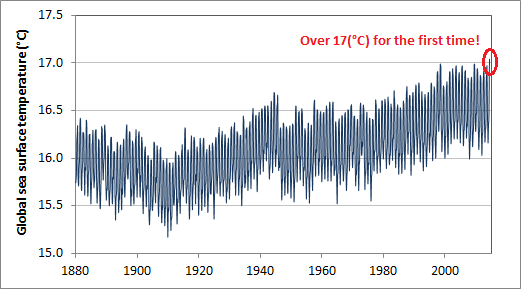Following on a study by my former student Sandra Banholzer and I about the influence of different types of El Niño on global temperatures, I sat down with UBC Public Affairs to answer some questions about the possible return of El Niño this winter.
When should we start to see El Niño develop and how will the average person notice it?
El Niño typically develops during our fall and reaches peak strength during our winter and early spring. Scientists are watching conditions in the Pacific Ocean to check early suspicions that a new  event is on the way.
event is on the way.
El Niño itself begins far away in the equatorial Pacific. A reversal of winds and currents brings unusually warm waters to an area between the coast of South America and the International Date Line. This is like dropping a huge rock in a stream. The warm waters release so much energy into the atmosphere that the normal flow of air is diverted, affecting weather all over the planet.
If a strong event develops, people across Western and Central Canada should see an unusually mild, dry winter and spring. On the other hand, people across parts of the southern U.S. should see unusually wet conditions.
Will climate change play a role in strengthening this El Niño?
Climate change affects everything that happens in the atmosphere and the ocean. The jury is still out on exactly how climate change affects the development of El Niño events.
One thing is certain: as the planet has warmed, El Niño events have also warmed. Our research shows that, all else being equal, an El Niño event today is warmer around the world than an identical event 100 years ago.
How could El Niño affect global agriculture and fishing?
El Niño is no joke. Regional heat and drought brought by a classic “Eastern Pacific” El Niño can be devastating to farmers in southern Africa, India, Southeast Asia, Australia, the Pacific Islands, and even the Canadian prairies. The warm El Niño waters also choke off the supply of nutrients to the great fisheries off the coast of South America. We’d all see the effect in global food prices.
One silver lining may be California. El Niño rains could offer a respite from the intense three-year drought that has crippled production in the Central Valley.
Will a potential El Niño affect global temperatures in the coming months?
In general, El Niño events are expected to cause a spike in global average temperature. But not all El Niño events are created equal. Research led by my former student Sandra Banholzer shows that only the classic events with the ocean warming in the eastern Pacific–as last happened in 1997/1998–definitely lead to an increase in global average temperature.
Since then, El Niño events have been more of the “Central Pacific” variety, which are not necessarily warm globally. The supposed “pause” in global warming over the past 15 years is nothing of the sort. The planet has been warming, but thanks to these naturally variable conditions in the Pacific, more heat than usual has gone into the ocean.
The overall global warming trend is so strong that even a weaker El Niño is enough to break global temperature records. This past May was already the warmest May in recorded history. If the overall Pacific pattern flips in the coming months, bringing a strong classic El Niño, we’re likely to shatter global temperature records.
 The oceans in June may have set an all-time heat record, according to data from the U.S. National Oceanic and Atmospheric Administration (NOAA). The global average sea surface temperature may have topped 17 °C for the first time in any month of any year since 1880.
The oceans in June may have set an all-time heat record, according to data from the U.S. National Oceanic and Atmospheric Administration (NOAA). The global average sea surface temperature may have topped 17 °C for the first time in any month of any year since 1880. 
 “Gaffers who claim that winters were harder when they were boys are quite right—except that the change is too small to be detected except by instruments and statistics in the hands of professional meteorologists. Weather men have no doubt that the world at least for the time being is growing warmer.”
“Gaffers who claim that winters were harder when they were boys are quite right—except that the change is too small to be detected except by instruments and statistics in the hands of professional meteorologists. Weather men have no doubt that the world at least for the time being is growing warmer.” The “ice season” on lakes and rivers all across the Northern Hemisphere has been shrinking. One of the
The “ice season” on lakes and rivers all across the Northern Hemisphere has been shrinking. One of the 
